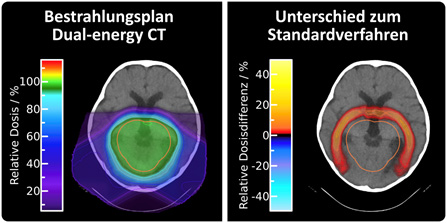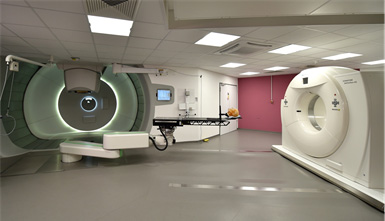Translation of Dual-Energy CT for range prediction in particle therapy
Project leaders:
Dr. rer. nat. Steffen Greilich (DKFZ, HIRO), s.greilich[at]dkfz.de
Dr. rer. medic. Christian Richter (OncoRay/HZDR, Dresden), christian.richter[at]oncoray.de
Funded since: October 2014
Scope
The aim of this NCRO joint funding project – initiated in 2014 – is to explore the potential benefit of dual-energy computed tomography (DECT) for particle therapy, and especially for range prediction, and to subsequently translate its findings into clinical routine.
Today, the ability of radiotherapy with protons and heavier ions to provide excellent target coverage and tissue sparing is largely undermined by uncertainties coming from the necessity to predict particle ranges on the basis of X-ray computed tomography (CT), i.e. photon absorption information. The current gold standard uses an empirical relation between CT numbers from a single CT-scan and particle ranges determined by the ‘stopping-power ratio’ (SPR). This conversion yields ambiguities and systematic deviations, but most notably it cannot deal sufficiently with tissue diversity and variability in humans. CT-scanners that can obtain two scans with different X-ray spectra were hypothesized to provide additional information needed for more accurate range prediction.
During this project, we were able to show that patient-specific, DECT-based range prediction is able to significantly reduce range prediction uncertainty, to account for tissue diversity and variability, and can be safely implemented in the clinical workflow.
Main achievements
- Provide a rigorous conceptual framework for the mathematical and physical basis of electron density and stopping power extraction from X-ray absorption.
- Development of a DECT-based range prediction algorithm, accounting for tissue mixtures and minimizing calibration uncertainties
- Extensive validation of DECT-based range prediction in realistic, heterogeneous, anthropomorphic geometries and biological tissue with high-accuracy measurements.
- Implementation of DECT scans for routine treatment planning in 2015
- Investigation of intra- and inter-patient tissue variabilities in CT-to-SPR conversion showing the potential of patient-individual DECT-based range prediction
- Investigating the deviation of current range prediction from DECT-based range prediction for a broad patient cohort
- Refinement of conventional CT-to-SPR conversion with information from cohort-analysis of DECT-based patient-specific range prediction
- Evaluation of the feasibility of virtual non-contrast CT datasets from contrast-enhanced DECT scans.
References:
- Wohlfahrt P, Möhler C, Stützer K, Greilich S, Richter C. Dual-energy CT based proton range prediction in head and pelvic tumor patients. Radiother Oncol, in press, 2017.
- Wohlfahrt P, Möhler C, Richter C, Greilich S. Evaluation of stopping-power prediction by dual- and single-energy computed tomography in an anthropomorphic ground-truth phantom. IJROBP, in press, 2017.
- Möhler C, Wohlfahrt P, Richter C, Greilich S. Methodological accuracy of image-based electron-density assessment using dual-energy computed tomography. Medical Physics 44:2429-2437, 2017.
- Wohlfahrt P, Möhler C, Greilich S, Richter C. Comment on "Dosimetric comparison of stopping power calibration with dual-energy CT and single-energy CT in proton therapy treatment planning". Medical Physics 44:5533-5536, 2017.
- Wohlfahrt P, Möhler C, Hietschold V, Menkel S, Greilich S, Krause M, Baumann M, Enghardt W, Richter C. Clinical implementation of dual-energy CT for proton treatment planning on pseudo-monoenergetic CT scans. IJROBP 97:427-434, 2017.
- Möhler C, Wohlfahrt P, Richter C, Greilich S. Range prediction for tissue mixtures based on dual-energy CT. PMB 61:N268-N275, 2016.

© OncoRay, Dresden

© OncoRay, Dresden






